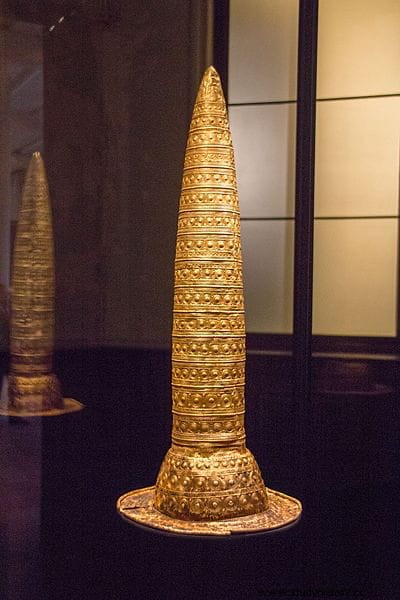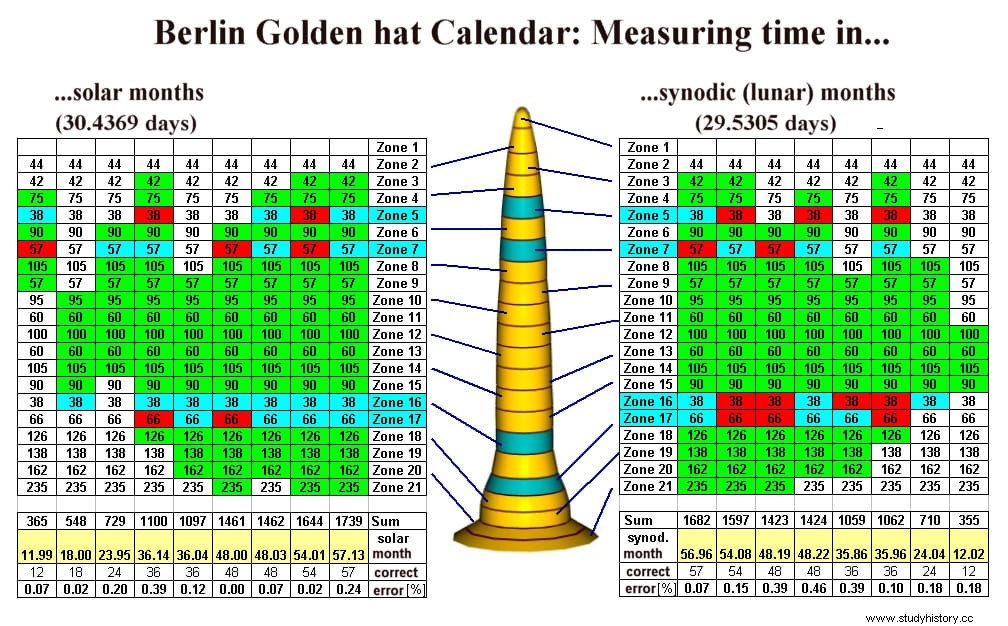Between the 19th and 20th centuries, four curious objects similar to large conical hats were found in southern Germany and France. They are made of thin sheets of gold and the researchers believe that they may be a kind of calendars. They all appear to have been deliberately and carefully buried nearly 3,000 years ago
The first was discovered in 1835 near the German town of Schifferstadt, in Rhineland-Palatinate. The second appeared in 1844 at Avanton, near Poitiers in France. Almost a century later, in 1953, the third was discovered in Ezelsdorf (Nuremberg, Germany). Of the room, acquired by the Museum of Prehistory and Ancient History in Berlin in 1996, both its date of discovery and the place are unknown, although it is believed that it could be Switzerland or southern Germany.

Although they cannot be dated precisely, the technology used suggests that they were made in the Late Bronze Age, the one at Schifferstadt around 1400-1300 BC, and the other three around 1000-800 BC. All four are attributed to the Urnfield Culture, which developed during the late Bronze Age and early Iron Age throughout much of Europe, from the Iberian Peninsula to the Baetic and the Danube.
According to Wolfram Euler, those who created the hats were undoubtedly speaking an Indo-European language, most likely an earlier or earlier form of Celtic . In addition, their similarity presupposes that they had cultural connections of some kind, although it cannot be determined if this was religious, cultural or ethnic.

The hats were attached externally to long conical headdresses, probably made of leather or some other organic material, which served to stabilize the external gold foil.
It is assumed that they are hats used by the priests of the ancient solar cult of Central Europe, because three of them have a cap-shaped enlargement at the bottom of the cone, with oval openings in diameter and shape approximately those of a human head. .

The height of the hats varies. The tallest of the three, the one in the Berlin museum, is 90 centimeters high, while the one in Schifferstadt is only 29.6 centimeters. The one in Avanton reaches up to 55 centimeters and the one in Ezelsdort, after reconstruction, is 88.3 centimeters high although it is possible that it was originally shorter.
The hats are made from an alloy that contains 85 to 90 percent gold, 10 percent silver, and less than 1 percent copper and tin. The gold sheets are in one piece, seamless and hammered to a thickness of between 0.25 (in the case of Schifferstadt) and 0.6 millimeters (in Berlin). For their size they are surprisingly light. The one from Ezelsdorf, which is 89 centimeters tall, weighs only 280 grams.
They are decorated with bands of geometric motifs, mainly discs and concentric circles that seem to follow systematic sequences. According to a study carried out by Wilfried Menghins, who was director of the Museum for Prehistory and Ancient History in Berlin until 2008, on the Berlin specimen, the hats may have a function as calendars. The symbols would form a lunisolar calendar, where each one (or each ring of a symbol) would represent a day.

The ornamental bands have different numbers of rings, and in the intercalated zones there are other apparently special symbols that may have had the function of adding or subtracting from the periods in question.
The exact knowledge of the solar year would have been of great interest in determining religious events such as the summer and winter solstices. However, it is not known if the hats were used to determine those dates or simply represented that knowledge.
In the case of the Berlin hat, this Menghins hypothesis allows counting up to 57 lunar months and 57 solar months, and a simple multiplication of these values would also allow the calculation of longer periods.

However, there is also a discrepancy of 2 days with respect to the exact astronomical value, which the researchers explain as the result of a slight inaccuracy in the observations made during the Bronze Age.
Taking into account the characteristics of the material used and the technical means available, the researchers believe that the production of these hats during the Bronze Age must have been a great craftsmanship and technological achievement.
